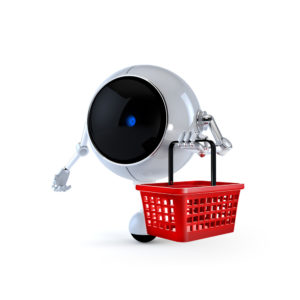Sand Hill
by Sanjay Parthasarathy, Founder and CEO Indix
Mobile computing and broadband wireless untethered us from desktops. Wearables (smart glasses, rings, watches, clothing and more), the Internet of Things (cars, home appliances, thermostats, billboards, vending machines, vacuum cleaners and the like) and local and micro-area networks (Wi-Fi, beacons, Bluetooth) are enabling pervasive computing.
Google recently announced a cutting-edge project – a “smart” contact lens that monitors a diabetic person’s glucose levels by testing the person’s tears using a tiny wireless chip and a miniaturized glucose sensor embedded in the lens. They hope to collaborate with partners to develop apps that will allow wearers and their doctors to directly access measurements and presumably provide the necessary and appropriate products and services to the wearer.
 Pervasive computing in turn is helping usher in a consumer-centric era of commerce where consumers will be able to get whatever they want, whenever they want, delivered wherever they want in a way that is most convenient to them.
Pervasive computing in turn is helping usher in a consumer-centric era of commerce where consumers will be able to get whatever they want, whenever they want, delivered wherever they want in a way that is most convenient to them.
With computer and communication networks everywhere and anywhere, the stage is set for dramatic changes in the way companies conduct commerce. We think of the next era of commerce as the era of pervasive commerce. Pervasive commerce is bringing about a paradigm shift in the way that we buy and sell products. In it, every interaction in the physical world or on the Web is an opportunity to inform, educate and buy or sell products and services.
Pervasive commerce is here in its earliest forms, and we need to be prepared. It wasn’t long ago that all commerce was destination commerce, wherein a consumer chose to visit a certain brick-and-mortar store, mall or ecommerce site. That transitioned into a multi-channel world where brands and merchants found it necessary to have multiple outlets for their products and services in the physical world and on the Web.
Omni-channel retailing
Omni-channel retailing evolved from the multi-channel model and focuses on generating a seamless brand experience for the “connected consumer” — in other words, a consumer with continuous access to pervasive computing. In omni-channel retailing, businesses strive to ensure that they coordinate their offers and promotions across channels, whether it is a mobile device, brick-and-mortar store, catalog, direct mail or television.
This type of retailing is more customer-centric and requires the retailer to be more in tune with the customer’s needs and preferences by analyzing past purchase behavior, social media affinities and so on.
Infinite-channel retailing
 However, omni-channel is but a stop on the path to pervasive commerce. We will move from an omni-channel to an infinite-channel retail model. In an infinite-channel world, every interaction with consumers in the physical world and virtual world will be an opportunity to “wow” them and market and sell products and services.
However, omni-channel is but a stop on the path to pervasive commerce. We will move from an omni-channel to an infinite-channel retail model. In an infinite-channel world, every interaction with consumers in the physical world and virtual world will be an opportunity to “wow” them and market and sell products and services.
In an infinite-channel world, companies will find new and interesting ways to increase the level of interaction with potential customers.
LA-based cupcake company Sprinkles uses curbside delivery for on-the-go customers. The interaction period may be limited, but the uniqueness of the service creates a memorable experience. Sprinkles also has cupcake ATMs that deliver fresh cupcakes to consumers via a robotic arm.
Last month, Amazon filed a patent for its “anticipatory shopping” system. This system is designed to cut delivery times by predicting what buyers will buy before they buy it. A sophisticated algorithm allows the system to thoroughly analyze a shopper’s buying and browsing history and have products packed and ready to be shipped from warehouses. This will be a remarkable breakthrough in online shopping, especially for products that consumers likely will want delivered on the day of release, such as popular books.
This kind of innovation and creativity will define the age of infinite channels and pervasive commerce.
This calls for technology advancements that don’t take away the element of choice and actually enhance the shopping experience by making it more relevant and personalized.
Pervasive commerce challenges
The limitless potential of pervasive commerce comes with its own set of challenges. However, when tackled smartly, these challenges actually will become key business strengths.
At this point, we see at least two challenges to effective pervasive commerce: 1) greater precision in matching the right product to the right person at the right time and 2) securing permission before doing so.
To be effective, pervasive commerce needs to be highly personalized. People don’t really connect with the ads that flood their email inbox as they are unsolicited and sometimes not relevant, though they may be based on contextual data collected from the user’s email.
Targeting can be much more precise if one has more data about the potential customer and about the products that the customer is or may be interested in. This is where Big Data and analytics technologies can really help. Armed with data about the potential customers and products, algorithms can get to work to find the exact right product for the right customer at the right time.
A lot of energy and investment has gone into collecting and analyzing data about consumers. Not enough effort has been made to deeply understand the world of products. When companies combine deep knowledge about products with deep knowledge of the customer, it enhances the shopping experience, and everybody benefits from the precision afforded by Big Data and analytics.
A case in point is Netflix, which has by far the deepest database of entertainment today. It actually paid people to watch films and tag dozens of different movie attributes, resulting in the formation of 76,892 micro-genres like “post-apocalyptic comedies about friendship. This product-attribute data combined with the data that Netflix has about its subscribers facilitates a comprehensive and satisfying entertainment experience — and a very lucrative one.
We call this deep data and insight about products “product data science.” The personalization of pervasive commerce will become a more real possibility with access to product data science.
Companies can then use actionable insights drawn from such rich product data to build more “product-aware” applications and services. In a product-aware world, if you like something that your friend is wearing, you can get access instantly to a product summary, price information, comparative reviews, availability and other attributes. You also will get related product offers and promotions based on your particular browsing patterns and purchase history.
Ultimately, product-aware apps will ensure that the right product information is matched with the right person at the right time. In short, the correct use of product data science and sophistication of Big Data technology will ensure precision targeting and revolutionize the consumer’s shopping experience.
The other hurdle that pervasive computing must overcome is that of an imminent threat to a consumer’s privacy. For instance, geo-fencing, where a customer is caught unaware and blasted with promotions and offers as soon as the customer is in the vicinity of a preferred store can be intrusive, not to mention counterproductive. There needs to be more subtlety and balance in the use of such technology.
One way to tackle this and not run the risk of customers being put off altogether is by gaining permission beforehand to access their information in the same way that apps do on Facebook and mobile phones. This will make consumers feel more empowered in how much they want to share. It also means they willingly lend themselves to a better, more targeted, more satisfying and more well-organized shopping experience. In the long run, it will result in both the buyer’s and seller’s favor and nurture the formation of a trusting relationship.
It is all about making every interaction personalized and time efficient for all involved parties while respecting privacy boundaries.
In 2014 we will see increased investment in product data science, particularly product intelligence, enabling apps, services and websites to become “product aware” and hyper-personalized. Combined with the investment that companies have made in understanding and predicting shoppers’ and shopping behavior, we will finally be able to deliver the right product information to the right person at the right time, resulting in customer delight. Win-win.
Sanjay Parthasarathy is founder and CEO at Indix, a software-as-a-service and Big Data product intelligence platform that enables businesses to explore, analyze, visualize and act on the world’s product-related information in real time. You can follow him on Twitter @SanjayPat.